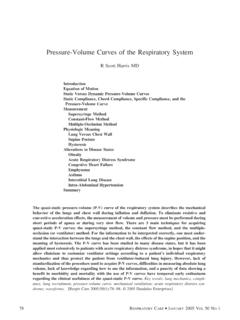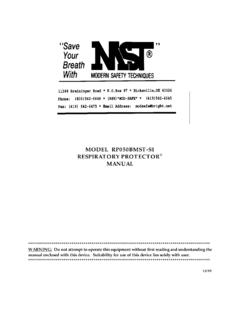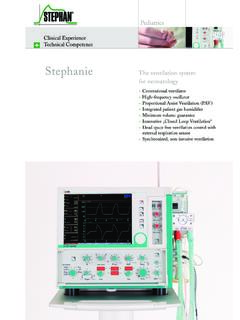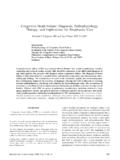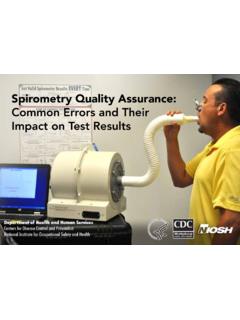Transcription of EVALUATION OF THE RESPIRATORY FUNCTION IN …
1 EVALUATION OF THE RESPIRATORY FUNCTION IN myasthenia gravis AN IMPORTANT TOOL FOR CLINICAL FEATURE AND DIAGNOSIS OF THE DISEASE PAULO A. P. SARAIVA*, JOS LAMARTINE DE ASSIS**, PAULO E. MARCHIORI** ABSTRACT - Myasthenic gravis may affect both inspiratory and expiratory muscles. RESPIRATORY involvement occurred in almost all patients with myasthenia gravis in all clinical forms of the disease: 332 lung FUNCTION tests done in 324 myasthenic patients without RESPIRATORY symptoms (age years) were examined. Lung volumes analysis showed that all the patients of both sexes with generalized or ocular myasthenia gravis showed "myasthenic pattern". Male patients with "ocular" form only presented the "myasthenic pattern" with lung impairment and had, from the lung FUNCTION point of view, a more benign behaviour.
2 Female patients with the "ocular" form exhibited a behaviour of RESPIRATORY variables similar to that of the generalized form. It was not observed modification of the variables that suggested obstruction of the higher airways. The "myasthenic pattern" was rarely observed in other neuromuscular diseases, except in patients with laryngeal stenosis. KEY WORDS: myasthenia gravis , lung FUNCTION tests, myasthenic pattern. Avalia o da fun o respirat ria na miastenia gravis : import ncia na caracteriza o cl nica e no diagn stico da doen a RESUMO - O comprometimento respirat rio fator limitante na evolu o clinica da miastenia gravis (MG) e as formas cl nicas mais graves apresentavam acometimento bulbar e respirat rio.
3 Para avaliar a reserva respirat ria foram examinados em 324 pacientes com MG (forma ocular 62, generalizada 246 e timomatosa 16) as seguintes vari veis da prova de fun o pulmonar (PFP): capacidade vital for ada (FVC); volume onde o fluxo expirat rio igual a 1 litro por segundo (VF=1); volume expirat rio for ado no primeiro segundo (FEV1); fluxo expirat rio for ado medido entre 0,2 e 1,2 litros (FEF); fluxo m dio expirat rio for ado, medido entre 25 e 75% da FVC (FMF); intervalo de tempo entre 25 e 75% da FVC (FMFT); tempo m dio de tr nsito na expira o for ada (MTT); capacidade pulmonar total (TLC); volume residual (RV); curva fluxo-volume para pesquisa do "padr o miast nico".
4 A an lise estat stica realizada foi: "t pareado" entre paciente e seu padr o e "t n o pareado" entre grupos. Conclus es: Todos os pacientes apresentaram o padr o miast nico e esta altera o da curva fluxo- volume sugeriu disfun o dos m sculos da laringe. Nos pacientes com formas clinicamente localizadas as PFP tamb m se mostraram alteradas revelando a generaliza o da sintomatologia mais frequentemente no sexo feminino. N o foi observada modifica o das vari veis que indicam obstru o das vias a reas decorrente do uso de anticolinester sicos no tratamento da MG nem aumento de incid ncia de asma br nquica com o uso de drogas anticolinester sicas. PALAVRAS-CHAVE: miastenia grave, provas funcionais respirat rias, padr o miast nico.
5 Acquired myasthenia gravis (MG) is a disease of neuromuscular transmission in which antibodies to the nicotinic acetylcholine receptor (AAChR) play an important role in the Laboratory of RESPIRATORY FUNCTION of the Orthopedic Department and Department of Neurology, Hospital das Cl nicas, S o Paulo University Medical Scool (FMUSP): *Chief of Pulmonary Test of the Orthopedic Department; **Associated Professor, Department of Neurology. Aceite: 19-juIho-1996. Dr. Paulo E. Marchiori - Cl nica Neurol gica, Hospital das Cl nicas, FMUSP - Av Dr. neas C. Aguiar 255 -01538-900 S o Paulo SP - Brasil. pathogenesis'-4,8. The clinical forms are: severe, which patients have RESPIRATORY involvement; accentuated, patients with bulbar symptoms without RESPIRATORY involvement; moderate, with only a motor dysfunction.
6 Further, there are systemic or localized (ocular) forms41115. Diagnosis is based upon the clinical findings, the electromyography (EMG) and on the serum levels of AAChR9101419. The seric levels of AAChR detectable in 68% of our myasthenic patients are important for diagnosis and responsible for the loss of the endplate acetylcholine receptor612. Unusually low levels of false positive serum concentration of AAChR were also found in other diseases. Furthermore, there is no specific , definitive and consensual diagnostic test for MG. myasthenia gravis may affect both inspiratory and expiratory muscles20. Aiming to study the impairement of other muscles in the localized or systemic forms of myasthenic patients lacking RESPIRATORY symptoms, an EVALUATION of lung functions was undertaken.
7 Lung FUNCTION tests (LFT) assure the concrete determination of the RESPIRATORY functional reserve through the analysis of different RESPIRATORY variables2-3-7. PATIENTS AND METHODS Three-hundred-thirty-two LFT of MG patients, confirmed by EMG and serum concentration of AAChR measuring the flow-volume curve were analysed and 324 of these patients were chosen as considered clinically stable, from a ventilatory point of view. Of those, 62 patients had a predominantly ocular form (POF), 27 were male (age 39 19 years) and 35 female (age 33 18 years); 246 had the generalized form, 68 were male (age 38 17 years) and 178 female (age 32 14 years); 16 had the thymomatous form, 8 male (age 38 26 years) and 8 female (age 44 21 years) (Table 1).
8 Three patients with oculopharyngeal dystrophy, 2 with inflammatory myositis, 2 with chronic demyelinating polyneuropathy, one with pseudomyasthenic syndrome, and one with upper stenosis of trachea were also evaluated. To plot the curves a vitalograph spyrometer was used and to analyse the shape of the curves the Hewlett Packard electronic Vertek spyrograph was used. RESPIRATORY muscle FUNCTION can be evaluated with several different maners. So, in this investigation, the variable of the LFT studied were: 1. Forced vital capacity (FVC); 2. Volume where the expiratory flow equals one liter per second (VF=1); 3. Forced expiratory volume in the first second (FEV1); 4.
9 Forced expiratory flow measured between and liters (FEF); 5. Median forced expiratory flow measured between 25 and 75% of FVC (FMF); 6. Time lapse between 25 and 75% of FVC (FMFT); 7. Average transit time of expiration (MTT); 8. Total lung capacity (TLC); 9. Residual volume (RV); 10. "Myasthenic pattern". The airways closure volume (CIV) has been used for many years - demanding expensive and specialized equipment and also a major participation of the patients, not guaranteed in many instances. It was observed that airway closure capacity was more reliable, although patient and equipment requirements were the same. We noted that they might undergo a different reference: instead of the end of FVC, not always stable, the beginning of the forced expiratory curve, and thus define a point called 'T'-where the expiratory flow is equal to one which presents a close correlation to FUNCTION of total lung capacity (TLC) and airways closure capacity (CIC).
10 The volume corresponding to point "J" was designated VF=1 with the same defining strenght of CIC, however much easier to measure and not requiring sophisticated and expensive equipment. All variables of the myasthenic patients were compared with the standard variables of the normal lung functional test. Statistical analysis used was: a) descriptive statistics; b) paired Student t test between the values of each different variable and its standard; c) unpaired Student t test between the different clinical forms. The number Cruncher Statistical System was used. RESULTS Table 1 shows the distribution of the patients. Table 2 shows the distribution of the diverse clinical forms according to sex, number of studied cases and presence or absence of really significant differences (RSD).










